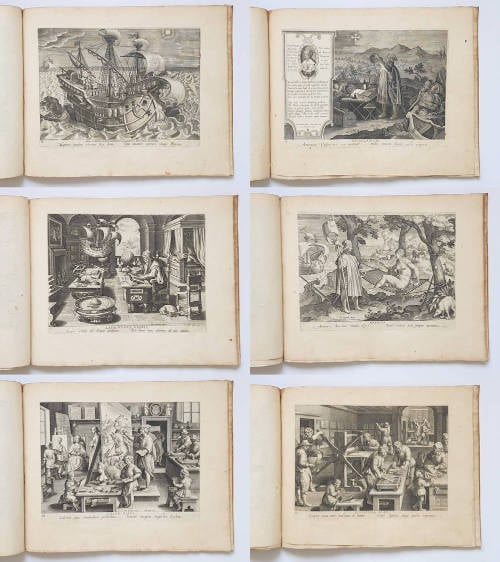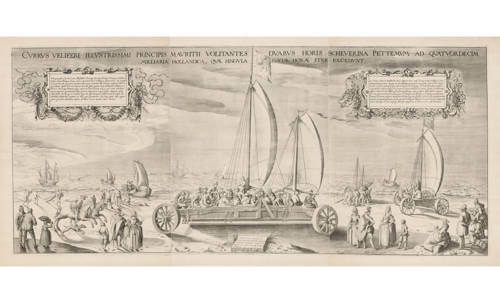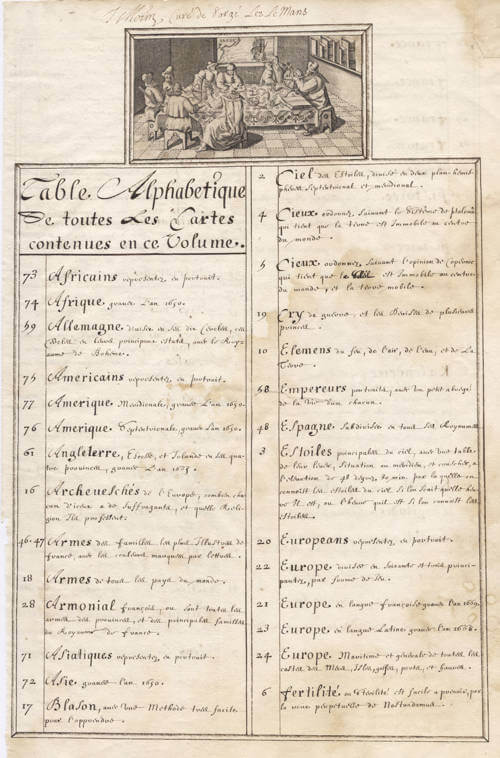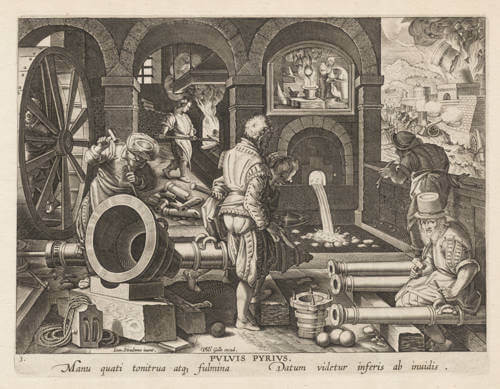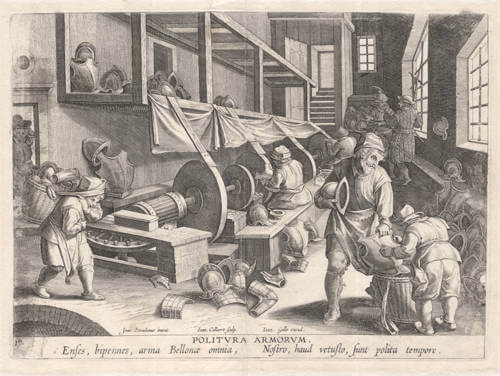Leen Helmink Antique Maps
Nova Reperta Complete Series by Johannes Stradanus
The item below has been sold, but if you enter your email address we will notify you in case we have another example that is not yet listed or as soon as we receive another example.
Stock number: 19046
Zoom ImageCartographer(s)
Johannes Stradanus (biography)
Title
Nova Reperta
First Published
Antwerp, 1588
This Edition
Most in 1588 1st edition 1st state
Technique
Condition
excellent
Price
This Item is Sold
Description
Iconic series of old master prints designed by Johannes Stradanus.
A rare complete series of Nova Reperta (Modern Inventions of our time), the images of which were designed by Flemish artist Johannes Stradanus (Jan van der Straet), then engraved in copper by Theodor(e) Galle and Ioan (Jan, Hans) Collaert, and published in print by Philip Galle in Antwerp. The full suite consists of a title page plus nineteen engraved prints of modern (post-classical) inventions and discoveries. The work is the best of its kind, and the images are used extensively in the literature to illustrate early inventions and technology.
The plates depict the discovery of America and the discovery of the southern cross with an astrolabium; various other inventions are illustrated including the compass, gunpowder, book printing, copper engraving, oil painting, clockwork, eyeglasses and distillation; among these are also the creation of the watermill and windmill, the invention of the olive press and the discovery of the longitudes.
Condition
Oblong 4° (336 x 290 mm including margins). The prints themselves ca 265 x 200 mm each. In later binding reusing old limp vellum.
Engraved title and 19 numbered plates. 17 of the 20 prints are FIRST EDITIONS, state I of IV, published by Philip Galle, and from a uniform set. The other three prints (title, 02, and 18) have been supplied from a different set, and are State III of IV, with publisher imprint of Carel de Mallery, Philip Galle's son in law.
Fine early imprints from the copperplate. No paper restorations or imperfections. Very wide paper margins. Excellent example of this significant series.
New Hollstein 322-341; Sabin 92666 and 92667.
Rarity
The complete series is of exceptional rarity, because at the time of publication the prints were sold unbound, as loose sheets or sets of loose sheets. Today only a handful of prestiguous institutions in the US and in Europe own complete series, most notably the Metropolitan in New York, The Newberry Library in Chicago, the British Museum in London and the Rijksmuseum in Amsterdam. These series were often assembled over many years or even centuries through acquisition and legacy donations either of loose prints or partial series, from several sources, in a variety of states, and are not uniform. There are no copies in institutions in Asia, Australia or on the Southern Hemisphere.
Overview of prints
The title page is illustrated with small pictures of the inventions and discoveries which are depicted in more detail in the first ten plates. The last nine plates may have been an afterthought, as they are not included on the title-page. The plates depict: Vespucci's discovery of America, an observatory, a gun-foundry, a printing press, a clock-maker's, medical care, a distillery, silk-manufacture, a farrier's, a water-mill, wind-mills, an oil-press, a sugar-factory, a painter's studio, an optician's, ship-navigation, an armory, an astrolabe demonstrated by Amerigo Vespucci, and a copperplate engraver's.
The twenty prints are organized and presented as follows, for a brief description of each print we refer to the online examples of the collections of the Metropolitan Museum and of the British Museum. For a more in-depth analysis, each print is discussed in detail in Lia Markey's recent book on the Nova Reperta and in the associated exhibition of the Newberry Library suite of prints.
00 - Title page "Nova Reperta" (New Discoveries/Inventions of our times)
01 - The discovery of America by Vespucci (some say Columbus)
02 - Compass
03 - Gunpowder and cannons
04 - Book printing
05 - Clockwork
06 - Medical cure for syphilis
07 - Distillation of alcohol
08 - Cultivation of silk from the silk worm
09 - Stirrups/horse gear
10 - Water mill
11 - Wind mill
12 - Olive oil press
13 - Sugar refining
14 - Oil painting
15 - Spectacles/Eyeglasses
16 - Ship navigation/Longitude determination
17 - Armory/Metal Polishing
18 - Astrolabium and the Southern Cross (demonstrated by Vespucci and with a poem by Dante)
19 - Copperplate engraving
Several of the original Stradanus design drawings for these prints have survived (in mirror image from the copperplate), for instance the discovery of America, now in the Metropolitan New York (Accession Number: 1974.205).
Renaissance Invention
Stradanus's Nova Reperta
The frontispiece (plate 1) of the Nova Reperta (New Discoveries) series of prints, designed by Johannes Stradanus (also known as Jan Van der Straet and Giovanni Stradanus) in the late 1580s in Florence, is an example of a self-consciously modern image. It revels in its state-of-the-art mechanical invention by presenting a printing press directly beneath its hovering printed title. Flanking this cuttingedge reproductive technology are two roundels: the one on the left displays a map of the New World, while the one on the right, a compass. Together with a personification of the past, who turns his back to the viewer, and a personification of the future, who points to the Americas, the upper register of the print makes a case for the main vehicles of change in the Renaissance. The bottom of the page reinforces this claim with its disparate array of significant inventions and discoveries, such as silkworms on a mulberry tree, the stirrup, the iron clock, the cannon, distillation tools, and guaiacum (thought to be a cure for syphilis).
The series that this image announces is composed of nineteen other engravings, each representing a new invention within a social or historical setting, often playing with temporality and place. For instance, in the eighth print of the series, which represents the cultivation of silk (plate 9), missionaries from the East inform Emperor Justinian of the marvelous silkworm while, in the background, female laborers in early modern garb toil away, cultivating the precious raw material. The images in the series appear in the following order (plates 2–20): America, magnet compass, gunpowder, printing press, iron clocks, cure for syphilis, distillation, silk, stirrups, water mill, windmill, olive oil press, sugar refinery, oil painting, eyeglasses, longitude, armor polishing, astrolabe, engraving.
These fantastical representations cannibalize imagery from sources as diverse as genre painting, festivals, emblem books, cartography, travel literature, and scientific and historical treatises. It is believed that the first nine engravings in the series were commissioned first since they relate to inventions in the frontispiece. After these nine engravings, there does not seem to be any hierarchy to the order of the ten prints that followed, though some of them relate to one another in sequence, such as the water mill and windmill (energy), olive press and sugar refinery (production of food), and oil painting and eyeglasses (visuality).
(Markey)
Joannes Stradanus - Nova Reperta
The print series »Nova reperta« (New inventions), which Stradanus drew in the third quarter of the 16th century, is a rich source for cultural history in general as well as for the history of technology in particular. The discoveries and inventions depicted here extend throughout the Middle Ages and the Renaissance epoch, but the workshops and the people in them generally belong to the artist's time.
The major technical developments of the high Middle Ages include the widespread expansion of the water wheel, which was already known in antiquity, and the introduction of the windmill in Europe. The author commemorates both engines (water wheel, wind wheel) his picture series. Together with the now also better-used animal force they helped to establish a civilization in the Middle Ages that no longer mainly used human muscle as it did in classical antiquity, but that learned more and more to make use of other forces with technical means. The mechanical clock and the spectacles, two inventions of the 13th century, which influenced the bourgeois life substantially, are shown to us in two particularly attractive pictures. The great inventions of the late Middle Ages, gunpowder and book printing, are also treated, but oil painting and the art of copper engraving are not forgotten either. In the fields of chemistry and chemical technology, the images include distillation, sugar and oil paint. The art of distillation had made significant progress since the high Middle Ages. The artist also devotes some quite compelling images to the geographical discoveries and their technical requirements. From a technical-historical point of view, the draftsman has really chosen the most essential inventions of the Middle Ages and the Renaissance as a theme.
The illustrator of the sheets is Bruges-born Jan van der Straet (1523-1605), who in Latin was called Stradanus and in Italian Stradano (or della Strada). Stradanus, painter and draftsman, worked mainly in Florence, where he belonged to the circle of the artist and art writer Giorgio Vasari. Like Vasari, Stradanus moved in the path of late Renaissance mannerism. Characteristic of the mannerism of Stradanus is the abundance of juxtaposed details, the extensive joy, the fragmentation of the space, the narrowness and compression of the images (for example the distillation print), the use of the picture in picture (for example the guaiac wood print) and the contortion of the figures (for example the copper engraving print).
From his Flemish motherland Stradanus brought with him the strong inclination for the powerful and the realistic depiction. Vasari praised Stradanus’ great drawing skills, his excellent ideas and his ingenuity. In the extensive work of Stradanus comes out a variety of pasteboards, which he delivered to the wall carpet manufacturer for the Medici family in Florence. Especially his hunting scenes made Stradanus famous. We encounter his paintings and frescoes mainly in Florence, such as in Palazzo Vecchio, where we also admire, among other things, his 1570 created painting of a distillation laboratory of Grand Duke Francesco I de 'Medici. The picture resembles the sheet "Distillatio”.
The drawings for the series "Nova reperta" were created by Stradanus in the third quarter of the 16th century. At the end of the 16th century, the Antwerp draftsman, engraver and engraver Philipp Galle had nine of these drawings and a title page engraved in copper by his son Theodor Galle. It was soon followed by another ten leaves that were engraved by Theodor Galle and Jan Collaert. On all engravings Stradanus is a draftsman (Inventor), indicated with »Ioan. Stradanus invent«. The engravers Theodor Galle and Jan Collaert (Inscribed "Theodor Galle sculp.", "loan Collaert sculp.") are only mentioned on some of the engravings. But the printer and publisher, Philipp Galle, is mentioned on all pages ("Phl's Galle excud."). The publisher had two pictures of each of the Latin verses put under the pictures.
The content-rich prints were sold well. In 1638, Johann Galle, grandson of Philipp and son of Theodor Galle, re-issued a fourth and final state of the series. On the copper plates, he changed the "Phls Galle excud." into "loan. Galle excud”. These late states are less desirable than the original ones published by Philipp Galle.
(Klemm)
Literature
New Hollstein, Dutch and Flemish Etchings, Engravings and Woodcuts 1450-1700, 322-341 (Johannes Stradanus).
Old Hollstein, Dutch and Flemish Etchings, Engravings and Woodcuts 1450-1700, 410-429 (Johannes Stradanus).
Sabin 92666 and 92667.
van Mander, Schilder-boeck, 1604, edition of 1618.
Sellink, Stradanus (1523-1605), Court Artist of the Medici, 2008.
Markey, Renaissance Invention - Stradanus's Nova Reperta, 2020.
Klemm, Joannes Stradanus - Nova Reperta, 1972.
Johannes Stradanus (1523-1605)
Johannes Stradanus, or Giovanni Stradano, or Jan van der Straet or van der Straat, or Stradanus or Stratensis (Bruges 1523 – Florence 2 November 1605) was a Flanders-born mannerist artist active mainly in 16th century Florence, Italy. Born in Bruges, he began his training in the shop of his father, then in Antwerp with Pieter Aertsen.
By 1545, he had joined the Antwerp guild of Saint Luke or painters' guild, the equivalent of the Roman (Accademia San Luca). He reached Florence in 1550, where he entered in the service of the Medici Dukes and Giorgio Vasari. The Medici court was his main patron, and he designed a number of scenes for tapestries and frescoes to decorate the Palazzo Vecchio in Florence, the Medici Villa at Poggio a Caiano, and providing illustrations for the Arazzeria Medicea. He also worked for the Pazzi Family in their estates in Montemurlo.
Many of his drawings became so popular they were translated into prints. Stradanus collaborated with printmakers Hieronymus Cock and the Galle family in Antwerp to produce hundreds of prints on a variety of subjects. He also worked with Francesco Salviati in the decoration of the Vatican Belvedere. He was one of the artists involved in the Studiolo of Francesco I (1567-1577), to which he contributed two paintings including "The Alchemist's Studio".
Karel van Mander wrote about Stradanus in his Schilder-boeck (book of famous painters), mentioning that he was 74 in 1603 and still a member of the Florence drawing academy. He also mentioned his pupil Antonio Tempesta, who painted ships and Amazon battle scenes (bataljes), mainly in 16th century Florence, Italy.
Johannes Stradanus is one of the most well-known unknown artists in history. Even though the Bruges-born painter (1523-1605) had a more than successful career in the highly competitive city of Florence in the second half of the 16th century, his name long remained a well-hidden secret for specialists only. Many of his works, though, are very well known.
Around 1570, Stradanus – who began as designer of tapestries and fresco painter in service of the Medici – started a second career as draughtsman and designer of hundreds of prints. These were engraved, published and distributed all over the then-known world by Antwerp publishers in huge numbers. It are these works – widely collected, copied and used – which secured Stradanus’s place in art history as an inventive and influential artist.
Johannes Stradanus died in Florence in 1605.
Literature
New Hollstein (Dutch and Flemish) 342-345 (Johannes Stradanus).
Stevens & Tooley: Map Collector 2, p.22-24, "One of the Rarest Picture Atlases".
van Mander: Schilder-boeck, 1604.
Sellink: Stradanus (1523-1605), Court Artist of the Medici, 2008.
Markey: Renaissance Invention - Stradanus's Nova Reperta, 2020.
